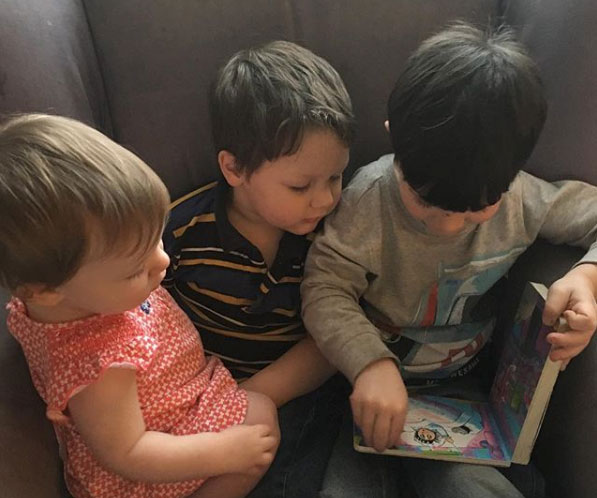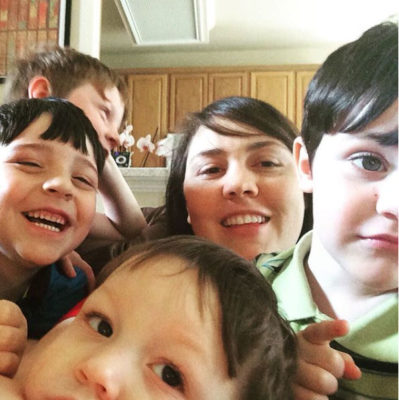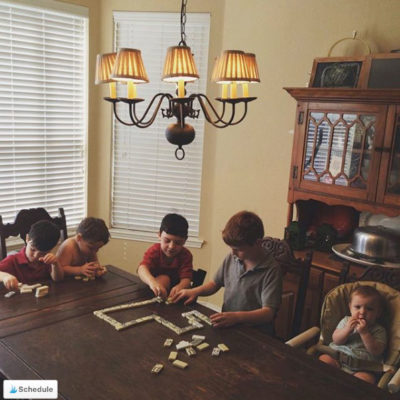
This post is part of our how to homeschool lots of kids with babies and toddlers series. Be sure to read the rest of the series.
“Love is a battlefield,” at least according to Pat Benatar.
But, I think many would agree that love in the form of homeschooling is a battlefield as well – especially when a toddler or baby are added to the ranks. We, however, need more than dated eighties dance moves to win this fight.
The crusade for our children’s hearts and minds is one of the most important wars we will wage in this life. Not just educations, but souls are at stake.
And, at times, it can feel like we’re being ambushed by the youngest members of our platoon. Our constitution (and patience) is weakened by newborn sleep deprivation. We step on the landmine of an erupting baby tooth or a toddler meltdown lobs a grenade into the midst of our routine math drills.
Other days we may face hand to hand combat with the enemy within through hopelessness and negative self-talk telling us our best efforts aren’t bringing us any closer to victory. These uncontrollable attacks are relentless. We weary and our battle fatigue is real.
But we can have hope. We were created for this conflict and have an arsenal at our disposal to help. Proverbs [21:31] tells us, “The horse is made ready for the day of battle, but victory rests with the Lord.” Yes, only God can make us triumphant, but we must also carry out our orders to be at the ready: sober, vigilant, prepared for the onslaught of enemy fire. (1 Peter 5:8)
Right before my only daughter joined our muster of all boys, I stumbled upon weapons in plain sight and changed the way I prepared our homeschool for more littles. With the use of these strategic sidearms, and in spite of the challenges of a newborn, our homeschool shaped up from “Praise Jesus, we survived!” to thriving in the trenches of that season of joyful chaos with thankful hearts.
That first year these practices were deployed to babyproof our homeschool we spent a couple weeks intensely focusing our energy reserves on their immediate implementation. After the bulk of that infrastructure was put in place, similar to the routine maintenance of other well used firearms, we periodically reset and reassess our homeschool. One of these occasions is before a new baby arrives.

Most of the time these tactics protect our school routines and defend my sanity, including days when the din of battle make it too loud to hear myself think. But, even when these evasive maneuvers are unsuccessful in preventing a tired toddler going berserk or the inevitable invasion of illness, the framework they provide allows me the brainspace to brave the incoming bombardment with courage and confidence instead of fear, dread, and confusion.
Now, my sisters in arms, I pray they help you vanquish any looming dragons threatening the peace in your homeschool with littles too.
1. Know your enemy (And no, it’s not your children…)
Our well intentioned expectations can be one of our biggest impediments when it comes to homeschooling with a baby, toddler, and/or preschooler. We can have many preconceived notions of how we want our homeschooling to run and when our reality does not reflect what we pictured it can be painful to accept.
As a second-generation homeschooler, I thought I had a clear vision of how our homeschool would operate. I’d lived it. But really I hadn’t.
My family of origin, with only three siblings and no littles during the majority of those school years looked nothing like my nuclear family, so I should not have been surprised when my homeschool didn’t either. My school days were quiet, self-motivated, and completed as quickly as I worked though my assignments.
In contrast, with always at least one baby and toddler running around, my homeschool now has a hum of ambient noise, twice as many in attendance, and has a more inclusive format and group focus.
When I stopped trying to force a system that didn’t fit the makeup of our family and find solutions that worked regardless of my original assumptions, the change was night and day. Look at your homeschool, what expectations have you been holding on to that should be adapted to the current stages of your children?
2. Work with the soldiers in your unit, not against them
A homeschooling family, like any other team, requires its members to work together. We celebrate and lean on our strengths and pull together to fill the gaps of our weaknesses. For our homeschool this means having a routine that makes allowances for the needs of our youngest children.
One way we do this is by pouring love, time, and attention into our littles at the beginning of the school day through age-appropriate books and activities. They are included in a tangible way and are then more willing to participate in the remainder of our Morning Liturgy (Morning Time) with a good attitude.
Additionally, around nap time, when 11 month old, JoeJoe, starts to get cranky, we have a scheduled recess. Once he’s asleep we begin the quieter activities of the day that require more diligence.
Weather permitting, outdoor time is also an enjoyable option for rowdy preschoolers prone to interrupt. And a younger sibling can be an appreciative buddy for reading practice too. If you have a new baby that’s not sleeping with any regularity, starting early in the morning may not be the best choice for a season.
Beginning your day an hour or two later than usual will not have a lasting negative effect on your homeschool. Observe the typical needs of your children and use the freedom homeschooling allows to order your day to benefit your whole family.
3. MREs (Meals Ready to Eat) are a must
I can’t tell you how many times I’ve been there. The boys and I are working intently and I make the mistake of glancing at the clock only to see it’s 4:00 pm and I have no earthly idea what we have to make for supper. Nothing derails our school day like having to stop and figure out what’s for lunch or dinner.
And honestly, with six kids, I have more important outlets for my brain power. That’s why I think every homeschooling family should have a simple meal-plan. Now I’m not campaigning for swanky gourmet repasts here, particularly when multiple littles are involved, but rather for a short list of easy to make meals you know your family will eat. Full disclosure: our family often eats cereal with fruit for breakfast and sandwiches for lunch.
That’s it. We double the portions of many of our suppers and freeze them for busier days and times of sickness. And my best trick for making meals healthier are those frozen vegetables in the microwaveable steam bags.
I haven’t jumped on the Instant Pot bandwagon yet, but I still love my Crock-Pot. Lastly, we’re also fans of repeating types of food on the same night of the week, like taco tuesday, fish friday, and the like. Consider what the tried and true recipes of your family are and go from there.
4. Gather all your tactical gear and hunker down
Maybe you’ve experienced this? You’ve just gotten everyone to your school area after breakfast and table chores are done then you realize the baby needs a clean diaper stat. So, you turn around and head for your supplies only to find that when you return everyone has vanished faster than a speeding bullet.
After about the fiftieth time, it dawned on me to put a little armory of baby goods in the Library with us. But I didn’t stop there.
Now every morning I think of anything we could possibly need during school time that day. All books, school time only activities for our younger kids, snacks, water bottles, fleeces in case of a sudden chill, bandaids, they all have a home in our school space. Any other excuse to leave the library is added to a list to be completed during our next break.

This strategy has been extremely helpful to me during the newborn days of even more diapers and feedings when I’m still healing and moving can be uncomfortable. I could also see the benefit of someone adding a miniature refrigerator to their space to accommodate formula feeding.
Take inventory of what you and your students need on a daily basis and see how many disappearing acts you can prevent in your homeschool while still tending to all the needs of your youngest attendees.
5. Ready the new recruits for action
“Never take a knife to a gunfight.” Or in other words: if you’re going to do something make sure you have the right tools for the job.
This is how I feel about having age-appropriate activities for babies, toddlers, and preschoolers in our homeschool. Our youngest soldiers should be armed for success too and our family does this by reserving special educational toys and activities for school time only.
These activities are kept in a bottom cabinet that is easily accessible and separated into containers that make tidying up possible for even our littlest set of hands. And by only coming out at school time, they keep their novelty longer.
Many of the activities for our 3 year old came from a local busy bag swap we participated in a couple years ago. They give him a lot of color and letter matching practice, as well as, fine motor skill training. You can find busy bag swaps on social media or organize one for local moms near you.

There are a wealth of ideas for the activities to include online. Presently our 2 year old and one year old are pulling out the hand puppets and peg dolls on a daily basis. You can find a stockpile of other ideas in my free guide, 50 Homeschool Activities for Littles.
When our littles are happily engaged in their own study alongside their older siblings we enjoy so much more peace throughout the homeschool day. They are included, they are learning, and they are quiet for the most part. Survey the toys your family already owns, what could be reassigned for your school area?
6. Make time for scheduled leave and debriefings
As a homeschooling mom to littles we are the ones called to meet the majority of our family’s unceasing needs. And as such we can feel that we can’t afford to step away for some time that is not other-focused. It is easy for our needs to lose their position to other things on our to-do list as wife, mother, and teacher because they seem more important.
I admit that securing time for self care has been an ongoing struggle that I’m still wrestling with, but I’ve seen time and again that you can’t fire a spent bullet. There has to be a charge, that is the propellant, my energy.
If I let myself get to the stress level of being completely shot, it takes more to be refreshed than if I had taken small scheduled moments for decompression. Without those breaks it is rare to find uninterrupted time to reflect on the day and earnestly evaluate what went well and what needs troubleshooting or discernment, but we all need those times for rest, for healing, and to be reminded of our gratitude.
I want to encourage you to challenge the prevalent perception of supermom and seriously consider what measures you can take today to preserve your health and well being through self care, and not just the physical aspect, but the spiritual, mental, and emotional aspects as well. You are needed, you are loved, and you are worth that investment of time.
We never know when the next attack to our homeschool will be just over the horizon, that is the nature of beast, but with a babyproofed homeschool we have done the reconnaissance to face our foe with determination and will have the reinforcements to never have to consider waving the white flag of surrender.
- Six Ways to Baby-Proof Your Homeschool - July 27, 2023
